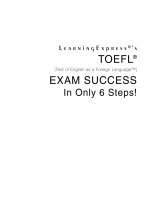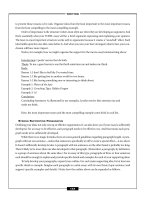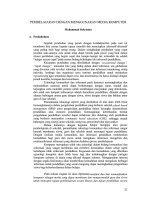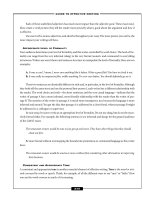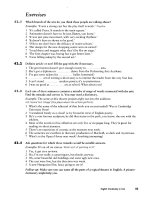Success step english 4 pdf
Bạn đang xem bản rút gọn của tài liệu. Xem và tải ngay bản đầy đủ của tài liệu tại đây (108.36 KB, 6 trang )
13
ᎏ
5
7
ᎏ
− 6
ᎏ
6
7
ᎏ
1. Notice the common denominator
of the fractions: 7
2. Add that number to the numerator
of the top fraction: 5 + 7 = 12
3. Subtract one from the top integer: 13 − 1 = 12
4. Subtract as usual: 12
ᎏ
1
7
2
ᎏ
−6
ᎏ
6
7
ᎏ
6
ᎏ
6
7
ᎏ
Multiplying and Dividing Fractions
When multiplying fractions, simply multiply the
numerators and then multiply the denominators:
ᎏ
5
6
ᎏ
×
ᎏ
7
8
ᎏ
=
ᎏ
3
4
5
8
ᎏ
When dividing, turn the second fraction upside-
down, then multiply across:
ᎏ
1
2
ᎏ
÷
ᎏ
2
3
ᎏ
is the same as
ᎏ
1
2
ᎏ
×
ᎏ
3
2
ᎏ
=
ᎏ
3
4
ᎏ
When working with problems that involve mixed
numbers such as 6
ᎏ
1
2
ᎏ
× 5
ᎏ
1
3
ᎏ
, change the numbers to
improper fractions before multiplying. With 6
ᎏ
1
2
ᎏ
,
multiply the denominator, 2, by the whole number, 6,
to get 12, then add the numerator, 1, for a total of 13.
Place 13 over the original denominator, 2. The result is
ᎏ
1
2
3
ᎏ
.
When multiplying or dividing a fraction and an
integer, place the integer over 1 and proceed as if it
were a fraction.
13 ×
ᎏ
1
2
ᎏ
=
ᎏ
1
1
3
ᎏ
×
ᎏ
1
2
ᎏ
=
ᎏ
1
2
3
ᎏ
= 6
ᎏ
1
2
ᎏ
Choosing an Answer
When you come up with an answer where the numer-
ator is more than the denominator, the answer may be
given in that form, as an improper fraction. But if the
answers are mixed numbers, divide the denominator
into the numerator. Any remainder is placed over the
original denominator. In the case of
ᎏ
20
6
8
ᎏ
, 208 divided
by 6 is 34 with a remainder of 4 yielding 34
ᎏ
4
6
ᎏ
. This
answer probably will not be there, so reduce
ᎏ
4
6
ᎏ
to
ᎏ
2
3
ᎏ
.If
ᎏ
20
6
8
ᎏ
is not an answer choice, 34
ᎏ
2
3
ᎏ
probably will be. But
don’t worry about having to choose between these two
answers. Since they signify the same amount, the test
would not be valid if both
ᎏ
20
6
8
ᎏ
and 34
ᎏ
2
3
ᎏ
were there
unless the question specifically asked for a fully
reduced answer.
HOT TIP
When you’re working with two fractions where the
numerator of one fraction can be divided by the same
number as the denominator of the other fraction, you can
reduce even before you multiply:
6
ᎏ
1
2
ᎏ
× 5
ᎏ
1
3
ᎏ
=
ᎏ
1
2
3
ᎏ
×
ᎏ
1
3
6
ᎏ
Divide both the 2 and the 16 by 2:
HOT TIP
When adding or subtracting fractions, you can use the
laser beam method.
1. First change to improper fractions, then multiply
crosswise:
2. Next, multiply the denominators: 6 × 7 = 42
3. Add or subtract the top numbers as appropriate and
place them over the multiplied denominator to get your
answer: 7 + 18 = 25
ᎏ
2
4
5
2
ᎏ
–CBEST MINI-COURSE–
103
1
6
3
7
7
18
1
6
3
7
+
=
13
2
16
3
104
3
2
3
×
==
1
8
34
Practice
Have you improved your skills with fractions? Try
these for practice:
1. 5
ᎏ
1
2
ᎏ
+ 4
ᎏ
2
3
ᎏ
+ 6
ᎏ
1
6
ᎏ
=
2. 3
ᎏ
1
6
1
ᎏ
× 1
ᎏ
3
1
9
ᎏ
=
3. 5
ᎏ
3
4
ᎏ
− 2
ᎏ
1
2
ᎏ
=
4. 8
ᎏ
1
8
ᎏ
− 2
ᎏ
5
8
ᎏ
=
5. A recipe called for 2
ᎏ
3
4
ᎏ
cups of flour. Jessica
wanted to triple the recipe. How much flour
would she need?
a. 7
ᎏ
3
4
ᎏ
b. 7
ᎏ
7
8
ᎏ
c. 8
ᎏ
1
4
ᎏ
d. 8
ᎏ
1
2
ᎏ
e. 8
ᎏ
3
4
ᎏ
Answers
1. 16
ᎏ
1
3
ᎏ
. The common denominator is 6 or 12.
2.
ᎏ
4
1
0
1
ᎏ
or 3
ᎏ
1
7
1
ᎏ
3. 3
ᎏ
1
4
ᎏ
4. 5
ᎏ
1
2
ᎏ
5. Jessica needs to multiply 2
ᎏ
3
4
ᎏ
cups of flour times 3.
2
ᎏ
3
4
ᎏ
× 3 =
ᎏ
1
4
1
ᎏ
×
ᎏ
3
1
ᎏ
=
ᎏ
3
4
3
ᎏ
= 8
ᎏ
1
4
ᎏ
For more practice, look at some of the books in
the “More Help” section.
Math 5: Measurement,
Perimeter, and Area
There are certain numbers, formulas, and measure-
ments, such as decimal equivalents, area formulas, and
weight conversions that you will be expected to have at
your fingertips when working some CBEST problems.
It’s a good idea to put them on flash cards for
memorization.
Common Measurements
You will be asked to figure problems using measure-
ments of length, weight, and volume as well as speed,
time, and temperature. Here are the common meas-
urements you may be asked to use. Knowledge of the
metric system was not on the CBEST when this book
went to print.
Weight Measurements
Weight measurements are usually measured on a scale.
1 pound = 16 ounces
1 ton = 2,000 pounds
Liquid and Dry Measurements
Liquid and dry measurements are usually made in a
measuring spoon, cup, or larger container. Think of
the dairy department of your grocery store. Units
smaller than a cup probably will not be on the test.
1 cup = 8 ounces
1 pint = 2 cups = 16 ounces
1 quart = 2 pints
1 quart = 4 cups = 32 ounces
ᎏ
1
2
ᎏ
gallon = 2 quarts
ᎏ
1
2
ᎏ
gallon = 4 pints = 8 cups
ᎏ
1
2
ᎏ
gallon = 64 ounces
1 gallon = 2 half gallons
1 gallon = 16 cups = 4 quarts
1 gallon = 128 ounces
Distance
Distance is measured by rulers or tape measures. Miles
are measured by odometers.
1 foot = 12 inches
1 yard = 3 feet
1 yard = 36 inches
–CBEST MINI-COURSE–
104
1 mile = 5,280 feet
1 mile = 1,760 yards
Square and Cubic Measurements
Here are some conversions you should know. You
won’t need to know any of the larger numbers on the
CBEST. For example, you won’t need to memorize
1,728—just be able to figure it out if you need it.
1 square foot = 144 square inches
1 cubic foot = 12 × 12 × 12 inches
or 1,728 cubic inches
1 yard = 3 feet
1 square yard = 9 square feet
1 cubic yard = 27 cubic feet
Temperature
Temperature is measured by a thermometer in degrees.
The only tricky thing here is to know that the differ-
ence between 40 below 0 and 65 above 0 is not 25, but
105. If you can’t visualize the distance between 40
below and 65 above 0, a rereading of Math Lesson 2 on
negative numbers might help.
Speed
Speed is usually measured by speedometers in miles
per hour. Time, distance, and rate problems are dis-
cussed in Math Lesson 7.
Time
Time is measured by a clock or by a calendar. You can
figure out the number of seconds in an hour (3,600) by
multiplying 60 seconds by 60 minutes.
1 minute = 60 seconds
1 hour = 60 minutes = 3,600 seconds
1 day = 24 hours = 1,440 minutes
1 week = 7 days = 168 hours
1 year = 12 months = 52 weeks = 365 days
Sample Measurement Question
1. Samuel, a friend of yours, has an uncle in the
wholesale fertilizer business. “And I don’t even
have a garden,” he remarked to you one day. The
two of you decide to make a garden in a 21 feet
by 25 feet patch in his back yard. You suggest he
put 4 inches of his uncle’s fertilizer on the top
and then dig it in. He asks you to help him
decide how much to order. Try to solve your
friend’s problem in cubic feet and write down
your answer.
You give Samuel your answer and he calls his
uncle. His uncle is most obliging, but insists that
since he’s a wholesale dealer, he can only accom-
modate orders in cubic yards. He also warns
Samuel that his fertilizer does not smell very
good, and needs to be dug in right away. You re-
figure your calculation in terms up cubic yards.
You finally come up with a figure and Samuel
calls his uncle. What is the amount he orders?
a. 9,600 cubic yards
b. 58.3 cubic yards
c. 19.4 cubic yards
d. 6.5 cubic yards
e. none of these
Answer
Look for your answer below and read to discover the
exciting conclusion.
a. 9,600 cubic yards. Suddenly, it grows dark. You try
looking out the window, but fertilizer is stacked
up against the window as high as you can see. You
can’t even get out of your house. You changed
everything to inches and divided by 36 because
there are 36 inches in a yard, so how could you
have been wrong?
b. 58.3 cubic yards. Suddenly, it grows dark. Your
windows are covered with fertilizer. Fertilizer is
–CBEST MINI-COURSE–
105
piled to the roof and the garden is buried. You
changed inches to feet and divided by 3, so where
did you go wrong?
c. 19.4 cubic yards. There is a pile of fertilizer about
three feet high covering your garden. This is more
than you expected so you pile it up and give it to
your neighbors. You were clued into the cube idea
and divided by 9, so why didn’t you get it right?
d. 6.5 cubic yards.You spread exactly 4 inches on top
of the garden with a rake. Quickly, you and
Samuel dig the fertilizer under. You feel proud
that you could get the right answer to a compli-
cated math problem.
e. You couldn’t find your answer so you redo your
math. You choose the closest answer.
In this volume problem, three dimensions need
to be multiplied to get a cubic measurement, but they
need to be in the same units of measurement. You can’t
multiply 21 feet by 4 inches. In this case, it is easiest to
change the 4 inches into feet. Four inches is
ᎏ
1
3
ᎏ
of a foot
and
ᎏ
1
3
ᎏ
of 21 is 7, times 25 is 175, the answer to the first
part of the question. Now that you’re working in cubic
feet, you need to convert to cubic yards.
Suppose you had a square with sides of one yard
each. Since there are 3 feet in a yard, a square yard
would include 9 square feet.
Now suppose you made your square into a cube.
You would have 3 layers of 9, or 27 square feet. So since
you need 175 cubic feet of fertilizer, you should divide
by 27 cubic feet: 175 ÷ 27 ≈ 6.5 cubic yards.
Practice
Try your hand at some additional measurement
problems.
2. Casey bought 3 lbs. 5 oz. of boneless chicken at
$1.60 per pound. How much did she pay?
a. $0.50
b. $4.80
c. $5.30
d. $8.80
e. $12.00
3. Frank cut 2′8′′ off a 6′3′′ board. How much was
left?
a. 3′5′′
b. 4′5′′
c. 3′7′′
d. 4′7′′
e. cannot be determined
4. Eight scouts each need two 3′ dowels for some
banners they are making. Before being cut, the
dowels are 10 feet long. How many dowels
should the scoutmaster buy?
a. 2
b. 3
c. 4
d. 5
e. 6
–CBEST MINI-COURSE–
106
5. Three full containers each held one of the fol-
lowing amounts: one ounce, one cup, and one
quart. If all three containers were dumped into a
gallon jar, how much room would be left?
a. 2
ᎏ
1
9
6
ᎏ
pints
b. 5
ᎏ
1
7
6
ᎏ
pints
c. 6
ᎏ
1
5
6
ᎏ
pints
d. 9
ᎏ
1
1
5
6
ᎏ
pints
e. 14
ᎏ
1
1
5
6
ᎏ
pints
6. A strip of wallpaper 5 yards long measured 5
inches wide. How many square feet of wallpaper
were there?
a. 6.25
b. 8.3
c. 60
d. 12.4
e. 19.7
7. Cooking a turkey takes 20 minutes for every
pound in an oven heated to 350 degrees. If a
turkey weighing 20 pounds has to be ready by
2:00
P.M., at the latest, when should the turkey be
put in the pre-heated oven?
a. 6:20
A.M.
b. 6:40
A.M.
c. 7:00
A.M.
d. 7:20
A.M.
e. 7:40
A.M.
Answers
2. This problem can be solved at least two ways. You
can turn the ounces into
ᎏ
1
5
6
ᎏ
of a pound and mul-
tiply 1.60 × 3
ᎏ
1
5
6
ᎏ
. Alternately, you can multiply
1.60 by 3, then multiply 1.60 by
ᎏ
1
5
6
ᎏ
and add the
two together. Choice c is the answer.
3. When subtracting 8 inches from 3 inches, borrow
one foot from the 6 feet. Add 12 inches to the 3
inches to get 15′′. 15 − 8 = 7 and 5 − 2 is 3. The
answer is c.
4. The trick here is to realize that the 10’ dowels are
really only good for 9’ since the scouts need 3’
pieces. The scouts need a total of 48’: 8 × 2 × 3 =
48. Five dowels would only be good for 45’, but six
dowels would provide more than enough (54’).
The answer is e.
5. There are 128 ounces in a gallon. 128 − 1 oz. =
127. 127 − 8 oz. (1 cup) = 119 oz. 119 − 32 oz.
(1 qt.) = 87 oz. There are 16 ounces in 1 pint, so
ᎏ
8
1
7
6
ᎏ
= 5
ᎏ
1
7
6
ᎏ
pt. The correct answer is b.
6. The easiest way to do this one is to change every-
thing to feet to begin with. 5 yards is 15 feet ×
ᎏ
1
5
2
ᎏ
= 6.25. The answer is a.
7. Multiply 20 × 20 to get the total time. Convert the
answer, 400, from minutes to hours by dividing by
60, to get 6
ᎏ
2
3
ᎏ
, or 6 hours, 40 minutes. From noon
to 2 p.m. is 2 hours. Subtract the remaining 4
hours and 40 minutes from 12 noon; think of 12
noon as 11 plus 60 minutes. 11:60 − 4:40 = 7:20
A
.M.
Perimeter and Area Formulas
Rectangle
Area: length times width (A = lw). One side times
the other side tells you how many fit inside.
Perimeter: 2 length + 2 width (2l + 2w). To meas-
ure all the way around something rectangular,
you need to include 2 lengths and 2 widths—
that’s all four sides.
HOT TIP
On the CBEST, there is usually one question that goes
something like this:
A school of 240 children want to go on a field trip. A bus
can hold 50 children. How many buses are needed?
Among the answers are 4, 4
ᎏ
4
5
ᎏ
, and 5. Four buses would
not be enough. There is no such thing as
ᎏ
4
5
ᎏ
of a bus. So
5 is the answer.
–CBEST MINI-COURSE–
107
Square
Measuring the area and perimeter of a square is basi-
cally the same as a rectangle, only the length and width
are the same measurement.
Area: side × side
Perimeter: side × 4
Triangle
Remember that a triangle is half a rectangle.
Area:
ᎏ
1
2
ᎏ
b × h. Multiply the height and the base.
Since the triangle is half, divide by two. Note:
The height of a triangle is not always one of the
sides. For example, in triangle ABC which fol-
lows, side AB is not the height, BD is the height.
AC is the base. To find the area, ignore all the
numbers but the base and the height. The base
can be found by adding 4 and 8: 4 + 8 = 12. The
height is 5.
ᎏ
1
2
ᎏ
× 5 × 12 =
ᎏ
6
2
0
ᎏ
or 30.
Perimeter: Add the sides all around: 12 + 6 + 9 = 27
Circle
The diameter of a circle goes from one point on the
circle, through the middle, and all the way across to
another point on the circle. The radius (r) is half of the
diameter. When working with π, consider the follow-
ing: The symbol π is usually found in the answers so
you don’t have to worry about converting it to a num-
ber. But if π is not found in the answers, and the ques-
tion calls for an approximate answer, substitute 3 for π.
The question may tell you to use
ᎏ
2
7
2
ᎏ
or 3.14.
Area: πr
2
. Square the radius and look at the answers.
If π is not found in the answers, multiply by 3. In
the example above, A = π4
2
or 16π.
Circumference: 2πr. Circumference is to a circle what
perimeter is to a rectangle. Multiply the radius by
2 and look for the answers. If π is not in the
answer choices, multiply by 3. In the example
above, the circumference is 2π4, or 8π.
Other Areas
Cut the figure into pieces, find the area of each, and
add. If you’re asked to find the area of a figure with a
piece cut out of it, find the area of the whole figure,
find the area of the piece, and subtract.
Other Perimeters
For any perimeter, just add the outside lengths all the
way around.
Practice
8. Find the area of a circle with a diameter of 6.
a. 36π
b. 24π
c. 16π
d. 9π
e. 6π
–CBEST MINI-COURSE–
108



